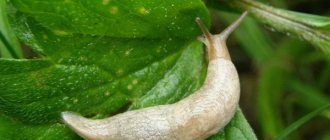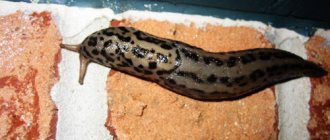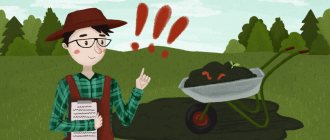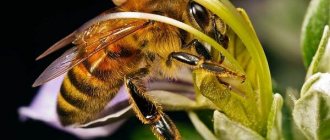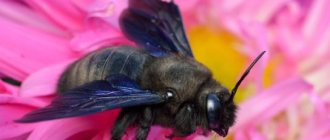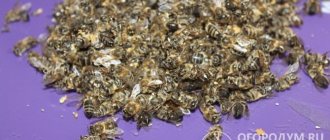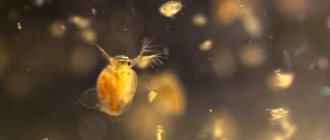In places far from industrialization, where wild bees live, these beneficial insects actively develop their livelihoods. They avoid people and build their nests in trees, bushes, and fortified hills.
You can see them extremely rarely, but there are cases of involuntary interaction between humans and forest inhabitants. Then it is important to have an idea of the peculiarities of their appearance and behavior in order to react to them correctly and not get hurt.
Description and characteristics
Wild bees are different from domestic ones. They are significantly smaller than the domestic specimen, with an average body length of 2-3 centimeters. They are distinguished by a uniform color, but there are specimens with several shades, usually muted, not as bright as those of their domesticated relatives. The chest is protected by a shell, the front wings are longer than the hind wings, and the hair is much thicker - it warms the insects in winter.
The largest wild bees live in Indonesia; their length can reach up to 39 mm.
On the back of the body there are black and yellow stripes and have wide, flat legs covered with hairs necessary for collecting pollen. The proboscis is well developed. The eyes are located so that almost everything falls into the insect's field of vision. Bees are able to see the road ahead and to the sides, as well as a little of what is behind us. The main defense of any bee is its sting. In the wild bee it predominates with a slightly different gland structure. At the same time, insects are not afraid to use their “weapons”; both noise and a bad smell can make them attack.
All wild bees are capable of pollinating various types of plants. Among them there are both solitary individuals and flocks of 20 thousand bees. Lonely insects pollinate plants, but are not able to produce honey. Most often, they organize worker colonies consisting of 20 working individuals. But such families can only exist for a year.
A distinctive feature of bees is their aggressive nature. As soon as they sense danger, they can use a glandular sting, which is found in both the queen and working individuals. They react to any noise and pungent smell, since wild bees have a huge number of enemies:
- Animals love to taste sweet honey. In such situations, insects often attack thieves in a swarm.
- Social insects, including the queen, workers, and male drones, are also considered enemies of wild bees.
The division of labor between individuals depends on the age of the insects. There are nurse bees, scout bees, forager bees, etc. The main function is fertilization of the uterus. After wintering they are not able to reproduce. Because of this, before cold weather, other individuals in the swarm drive them out of the hive.
The queen lays eggs. The worker bees obey her. They can collect nectar, raise brood, and more. They are characterized by increased resistance to most diseases that are fatal for domestic insects. Wild bees can tolerate frosts down to -50 degrees. They have a more toxic poison.
Bee jelly therapy
Along with bee venom, royal jelly is used to treat a number of diseases. It has a wide range of properties: antimicrobial, anti-inflammatory, antiviral, antispasmodic, regenerative and others. You can use royal jelly at home in the following cases:
- For influenza and ARVI: 5 g of honey with beebread (2:1), 10 g of pollen, 0.07 g of royal jelly, glucose. Take in the morning under the tongue for 20 days;
- 20-40 mg of royal jelly three times a day for 2-3 weeks.
With proper care and maintenance, even a small apiary will have a beneficial effect on your family’s health and financial situation.
Dangerous “wild” individuals
Wild bees, living in natural conditions and not tamed by humans, can be very dangerous. They are inclined to immediately defend themselves in case of any danger approaching them. Insects are aggressive in nature and can bite both animals and humans. If wild bees have settled near the house, this neighborhood is very unpleasant, not only because the noise that a swarm of bees will make will disturb you, but because their bites can become a serious problem.
A bee sting can make a person with allergies feel ill. If a person is bitten by several wild bees at the same time, this can turn into a tragedy - the venom of insects is very concentrated than that of their domestic relatives.
If you are bitten by a wild bee, call an ambulance or take the following measures:
- Remove the sting.
- Treat the wound with alcohol.
- To remove the poison, thoroughly rinse the wound with salt water.
- After all procedures, apply a piece of ice or a cold compress to the bite site.
You need to drink a lot of fluids containing ascorbic acid. This could be rosehip infusion or tea with lemon.
What they look like
How do wild bees differ from swarms that have recently flown away from their owners:
- The coloring of wild individuals is not as elegant as that of human-bred breeds. It depends on the climate and habitat of the population. The abdomen is painted in dark muted tones from light gray to black. The stripes are almost invisible. Modest coloring is less attractive to predators - hornets or birds.
- They have a dense shell on their chest. Very thick hair does not allow one to freeze in cold weather. They are very hardy and rarely get sick.
- They are aggressive. If they are disturbed, they attack in a swarm.
- Forest bees are usually small, about 3 mm in size, and are very fast and fussy.
- They are distinguished by high efficiency. In winter, a bee swarm can only die from starvation, so large food reserves are the key to a successful winter.
The lower entrance is usually at a height of 5-7 meters. The nest is most often located on the south side of the tree.
https://www.youtube.com/watch?v=lQE-3CTKs_g
The bee family builds its housing according to a “master plan” that strictly corresponds to the size and shape of the hollow and the location of the entrance.
Bees start making their home from the bottom. 5-7 wax plates are built, and the distance between them is exactly 12.5 mm. The honeycombs are tightly attached to the sides and top. They are elongated on the sides and oval at the bottom. The size depends on the number of bees in the family, location, construction time. As the family grows, the size of the nest increases to 2 meters in diameter. The bees will close up a hole that is too large, and a hole that is too small will be crushed.
What kind of wild bees are there?
According to their organization, representatives of the bee species are divided into several forms:
- Singles. In nature there are many varieties of bees that lead a solitary lifestyle. One female lays eggs and raises the offspring. Such bees do not tend to produce wax and honey, and pollination often occurs according to the type: one variety of bees - one type of plant. If the population of a particular species of wild solitary bee disappears, the threat of extinction of the corresponding plants increases to the limit.
- Semi-public. These bees have not been studied, but it is known that there are many such varieties. Bees tend to group into small colonies, usually 10-12 individuals. This group has a minimum of worker bees. Such bees live only 1 year; only the most fertile females are able to survive the winter.
- Public. Such bee colonies are characterized by increased resistance to diseases. They are characterized by high working capacity, slightly smaller in size compared to domestic bees. Some varieties have a thick fleecy coating and are aggressive in nature.
Benefits of Honey Bees
The main importance of honey bees for humans is in their production of:
- honey;
- wax;
- propolis;
- pollen;
- royal jelly.
These products are used in medicine, cosmetics industry, and food production.
In addition, bees are one of the best pollinators among insects. If the hives are located near fields with buckwheat, sunflowers or orchards, the yield can increase several times.
An apiary located near commercial crops is a guarantee of high yields
Productivity increases - human well-being increases, the green cover of the planet grows, the diversity of plant species does not decrease. Plants enrich the air with oxygen and purify the air - that is, bees make a significant contribution to the ecological stability of the Earth.
Where do they live?
A valuable species is the honey bee, which is very rare today. Many individuals live in Bashkiria; a lot of work is being done to preserve this species: entire reserves are being built with an abundance of hollow trees, which ensures the survival of bees.
As a rule, bees settle in tree hollows, but often in practice it turns out differently. The main condition is the presence of a spacious place, protected from direct sunlight and strong winds. It is very important that there is a body of water nearby. For this reason, bees are often found in rock or earthen crevices.
Over time, wild bees chose to settle next to people, which is why insects often choose an attic, a secluded corner in a barn or garage for their home.
Features of the genus Apis
Some bee species build a single honeycomb plate. They cannot live inside the hive.
Honeycombs on branches
The number of families in this case will be small. The basis of the structure is tree branches.
Where to find
The table lists the species belonging to the genus Apis.
| Advantage/disadvantage/neutral quality (+/–/0) | ||
| From a general point of view | For the breeder | |
| Aggressiveness | – | |
| Tendency to swarm | – | 0 (or +) |
| Frost resistance | + | + |
| Immunity to certain diseases (see below) | + | + |
| Low theft | + |
Hives should be looked for in tree hollows, as well as in the ground in fields and meadows. It should be noted that Apis Florea is a species that is resistant to high temperatures. In this species, the temperature balance is shifted 10 degrees upward, and the bees feel good even at +50 C.
Species Florea, features
The main habitat for Apis Florea bees is not Siberia or India, but the Persian Gulf.
It is clear that the habitat cannot be the taiga massif. We need honey plants, that is, plants that produce nectar. Insects of the genus Apis settle in the hollows of the following trees: aspen, willow, and less commonly, linden. And giant bee colonies can live in the cracks of aspen or poplar trees. In one fissure, a hive of wild bees was found, the length of which exceeded 5 meters.
Any bee colony consists of a queen bee, tens or hundreds of drones and thousands of workers. Only the latter can sting, but their venom causes allergies. A queen bee can sting another insect. It is distinguished by its increased body length.
The hive can be located hundreds of meters from the reservoir. Then the reservoir is a source of drinking. In June, during haymaking, many hive nests are found in the meadows. And you can notice that there is a source of water nearby. In a forest or shelter belt, this rule is not followed. But the facts are known:
- The lower entrance in a tree with a hollow is located at a height of 5-7 meters;
- Sometimes the height reaches 20 meters;
- Bees can be smoked out through the entrance, but it will not be possible to remove the honeycomb from the hollow.
How to remove honey
To remove honey from the honeycomb, you need to remove the honeycomb from the hive. And if the nest is in a tree, the trunk has to be cut down...
Beehive in an aspen hollow
Everything that is said below is considered poaching:
- All tapholes are sealed with a mixture of clay and water;
- The trunk is cut down;
- Saw the hive in half.
This is the only way to get to the honey, continuously using the smoker.
How to search and catch
You can determine where the nest is located in different ways:
- They track where the bees fly after watering;
- In the spring, before the first flight, everything unnecessary is thrown out of the hive: litter, dead bees, etc. And if the snow has not yet melted, the remains of litter will be visible from afar.
- From the last days of May you can use bait - troughs attached with ropes to poles. Honey is poured into the trough, but it is better to use a mixture of honey and water.
This mixture is called “full” - it is one of the favorite treats of bees.
Trap designs
Sometimes traps are also used. They are divided into two types: those that do not kill individuals and those that kill. The killing trap is an ordinary plastic bottle (see photo).
About life
Bees lead an active lifestyle. They are hard workers who care about creating comfortable conditions. They tend to build a house, reproduce and eat.
How are houses built?
Wild bees are able to build their homes both in the ground and in a hollow tree. When building a house in the ground, the home is more like a tunnel with various branches and exits. There may be a large house underground where a huge bee colony lives. The construction process is quite complicated. It is common for a bee to make a passage in the ground, and it needs to take care that the ground does not collapse during the passage. For these purposes, the insect uses its saliva; after strengthening the walls, the entire house is additionally lubricated with abdominal secretions.
After hardening, the home will not suffer either from rain or from the collapse of the earth, because the walls are firmly hardened and are not afraid of any weather conditions. Bees lay eggs in the house and store the nectar they collect.
But honey bees like to live in the hollow of a tree, since there is a need to process nectar. If you look inside their home, you will find many honeycombs occupying the area of the hollow.
What do they eat?
The food for any wild bee is nectar collected from plants and flowers. Wild bees prefer plants such as sage, linden, bird cherry, and chicory. They are also attracted to coltsfoot, thyme and other fragrant plants.
Reproduction process
After the queen bee flies out of the nest, she is accompanied by drones. During the mating flight, the male and female mate. The queen returns to the nest, where she lays up to 2 thousand eggs daily, while drones that are no longer needed are expelled.
The lifespan of the uterus is about 5 years. During this period of time, she manages to lay more than 2 million eggs.
Where and how do they winter?
A distinctive characteristic of bees is their sensitivity to cold, which is why beekeepers have to carry out a huge number of activities so that the insects can survive the cold without much loss. Nobody creates such conditions for wild bees, and they have to take care of themselves:
- Insects obtain food for themselves by stocking up on huge amounts of food for the winter.
- They drive drones out of their home, continue to actively reproduce and equip their home. If there are any cracks or holes in it, they are immediately repaired.
- Honey bees migrate to the lower part of their home, where there are no food supplies. Here they form a ball and are in constant motion. If they stop, they will freeze and die.
Appearance of bees
Their unusual color embodied the well-known one - yellow spots on a dark background - an excellent combination and very noticeable! This bee color signals to others that it is poisonous.
- If you offend a bee, it “fights back” with its sting measuring 3-45 mm, which is located on its abdomen.
- There are large eyes on the head, which enable the bee to see objects located at long distances.
- The remaining several eyes perceive nearby objects. That’s why bees’ vision is called mosaic.
- The bee's sense organs are represented by a pair of antennae.
On the bee's back there are two pairs of membranous wings, which are equipped with powerful muscles to enable flight. Three pairs of bee legs are attached to the back, and all the internal organs are located in the abdomen.
The abdomen tends to increase in volume - there are rings inside it that ensure this mobility. At the end of the abdomen there is a sting containing poison (apitoxin) - the bee’s protection from the outside world. The male (drone) does not have a stinger.
True, having stung someone, a bee says goodbye to its life.
Bees are the kings of the air element - in one second they make about 450 wing flaps, while having only 4 wings. An insect needs just a minute to cover a kilometer, and to find nectar, a bee can cover distances of up to 10 kilometers.
Hives
There are various types of hives found in the natural environment, including those located in trees. They are small bags made from dried leaves, grass and natural adhesives. Before the onset of cold weather, bees actively work: they cover cracks with propolis, raise young brood, and drive out lazy drones.
After the work is completed, the bees gather at the bottom of the hive; this place is considered the warmest; there are no honeycombs in it.
Earth bees, like ants, live in groups and dig through a lot of tunnels underground. At the end of the move, they locate a hole, compacting it with their paws and wetting it with their saliva.
This is how bees create compact and safe homes for themselves, each of which contains an egg on a cushion of flower nectar. The saliva hardens and becomes a hard film, due to which neither water nor cold penetrates into the houses.
Reproduction
Striped workers are born with the help of a uterus, which has developed genital organs (ovaries).
- Moreover, each family has only one queen.
- Bees mate outside the hive during a “romantic” flight.
- After this, the queen lays her eggs in the free cells of the honeycomb.
- Eggs can be fertilized (from which other queens and worker bees emerge) or unfertilized - from which drones emerge.
How are wild bees different from domestic insects?
Due to the fact that both domestic and wild bees belong to the same species category, they still share common features:
- both domestic and wild bee colonies live in close-knit organized groups;
- these both species use a sting when they sense approaching danger;
- each bee in the hive performs its duties: worker bees, drones, queen, honey bees;
- have the same body parts, and the distinguishing features are little things;
- To deposit honey, both domestic and wild bees create honeycombs.
Bees differ in the following characteristics:
- Wild bees are predominantly gray in color; there is no characteristic yellow color. Some varieties do not have clear stripes on the body at all.
- A wild bee has an aggressive character and is capable of attacking an animal or person if it does not like the smell or the slightest noise.
- Wild individuals have strong immunity, which cannot be said about domestic bees. They can even survive cold temperatures of -50 degrees.
- Undomesticated insects are characterized by hard work, activity, and the ability to collect nectar and make honey. As a result, wild bees stock up on food in preparation for cold weather.
- Some wild representatives have a “fur” covering and a protective shell on the chest.
- Wild honey bees have a smaller body than domestic bees, reaching an average of 2-3 centimeters in length. But there are also large representatives.
Body structure
The basis of a bee's body is its exoskeleton; it connects three main parts: the head, thorax and abdomen. The body parts are connected by strong but very light elastic membranes.
In the upper section there are:
- antennae;
- mouth;
- unique eye structure.
In the chest there are two rows of wings with membranes.
A clear example of the body structure of any honey bee
Six legs are attached to the abdomen. The bee is covered with thin hairs, which not only protect from external influences, but also help to navigate in space.
Organs of movement
The bee has wings and legs that allow it to fly and crawl quite quickly.
Wings with membranes - in two rows. As soon as the bee begins to fly, the wings interlock with each other, which allows them to lift a fairly heavy body into the air.
Six legs are located on the abdomen.
A special feature of the legs is the presence of special scrapers; with them the insect carefully cleans pollen from the legs when it flies from flower to flower or brings nectar to the hive.
Sense organs
Bees have organs of touch, smell, taste and vision.
The honey bee has a very sophisticated system of facet vision. This system allows the insect to recognize 5 colors, plant shapes, inspect a large area during the flight and distinguish the outlines of flowers even in the absence of bright sun.
There are no ears in the usual sense, but bees can hear - insects have special auditory openings on their bodies
The antennae play an important role in the orientation process - with them the bee feels the space inside the dark hive, determines the temperature and monitors the humidity.
There are unusual endings in the mouth - they allow honey insects to determine the quality and taste of nectar.
It is curious that taste can be recognized by special endings located not only in the mouth (throat), but also on the proboscis, thin antennae and even on the paws!
Respiratory system
The respiratory system is impressive - the insect must receive enough oxygen both in flight and in conditions of limited air flow in the hive.
The system consists of paired stomata on the body:
- 6 on the chest;
- 12 – on the abdomen.
The air is purified through special hairs, then fills special bubbles resembling lungs and spreads throughout the body. The exhaust air is exhaled through the third pair of holes in the thoracic region.
Digestive system
The digestive system of an insect consists of three sections. The first includes:
- oral cavity;
- esophagus;
- special bag for honey.
The honey sac or honey crop of a bee is located inside, near the hind pair of legs.
The middle section contains the stomach, and the lower section contains the intestines. The glands - salivary and subpharyngeal - not only help digest food, but also turn nectar into honey.
How to get rid of wild bees?
Unlike simple, domestic insects, wild bees are considered very dangerous. Their venom is much more toxic, which is why the bite can pose a serious threat, especially for a child or a person suffering from allergies. A mass attack can be fatal. It is important to know how to properly drive out wild bees if they settle in an area already occupied by humans.
Initially, a simpler method is used: they call a veterinary service or any similar organization that can catch the insects and relocate them to a safe habitat for them.
If there is no such service in the city, you will have to solve the current problem yourself:
- It is necessary to create a bait hive - an ordinary wooden or cardboard box disguised as a tree.
- After preparing the bait, it is placed near the home of wild bees; queen pheromone or lemongrass oil is dripped into the false hive; this attracts the attention of insects. Bees are especially sensitive to odors, due to which they will quickly move to a new place if they like it.
- After the bees move in, having first put on a protective suit, the hive is closed and placed in a tight bag.
- Finding a new home for bees becomes a difficult task in such a situation. They are transferred or transported to a new place, the bag is removed so that the insects do not behave aggressively, and they are smoked with a smoker. The hive is not taken away, it is left with the bees.
Features of caring for bees
You can raise bees in any climate - in gardens, in the country, and even on the balcony of your home. But it is best, of course, to raise bees in a large garden with an abundance of flowers and plants. This is a guarantee of the quality of the future product and a guarantee of providing the bees with food.
Before purchasing a hive, you will probably be puzzled by the question - what will the neighbors say?
- If the apiary is located on a large plot in the garden, it is unlikely that the neighbor will notice the appearance of “new residents”, but for smaller plots you need to especially carefully select your new charges so that they are non-aggressive and fairly calm.
- Before you buy striped friends, read the detailed “instructions”, look at photos of domestic bees, study their varieties and, of course, get a uniform - a beekeeper’s protective suit.
- This magical item will allow you to enjoy the process of communicating with bees and will protect you from possible stings. To complete the look, wear appropriate gloves and use rubber boots.
In the process of keeping “striped” insects, you may discover that you have an allergy or understand that keeping too many is such a troublesome and vain matter - not for you.
In such situations, you will already be thinking about how to get rid of domestic bees without causing damage to them and yourself. But here you need to make the right choice and make a balanced decision, because bees are a part of living nature, they provide a prosperous habitat for humans.
They, like magicians, produce a valuable product from plant pollen. Honey from domestic bees is an incredibly valuable food product, enriched with vitamins and healing properties. At present, there is no doubt that all the products produced by the honey bee are of great value.
Catching bees and breeding them
To catch wild bees, beekeepers use a special trap, which is made of ordinary plywood, and also carry out the following manipulations:
- Make a box where 4-8 frames are installed. Several frames with old honeycombs are suitable as bait, the rest are tightened with wire.
- Next, you need to climb a tree at a level of 3-6 meters above the ground and hang a trap. It is advisable to install the structure on a tree near a clearing or clearing, preferably if there are coniferous trees around.
- The box is secured using slings or ropes. Then leave it for a while. The capture of bees especially occurs during the swarming period, which lasts from May 25 to July 10. The trap is checked every 7-10 days.
- After the swarm moves into the box, it is carefully removed from the tree and transferred to the desired location. The operation is performed after sunset, when all the workers have returned to their new home. They quietly climb the tree and close the container, securing it well so that when they descend to the ground, the box does not open. It must be taken into account that the weight of the captured swarm and the box as a whole will be more than 5 kilograms.
It is possible to trap a swarm of wild bees, but breeding them at home will not be possible. Experienced beekeepers install cut logs in forests and near houses in Bashkiria. This is beekeeping, which is considered a very ancient type of beekeeping. In such a deck, the swarm will continue to live its usual life, and the beekeeper’s main task is to timely collect honey from wild bees.
Insects are very selective, which is why they are not always ready to move to any wood. It is recommended to rub the cut logs with aromatic herbs, build honeycombs, and only after settling in, collect some of the honey. Otherwise, the bees may fly away from the ruined nest. If they have chosen a place, then they can take root in it.
History of origin
Scientists and archaeologists have established that the age of honey insects reaches more than 100 million years. This is proven by the remains found in Southeast Asia. It is where wild bees live to this day that their global spread throughout the world began.
First, it was located in the territories of India, followed by distribution throughout the countries of the Middle East, then Egypt and all of Africa. They came to our homeland by traveling through Central Europe all the way to the Ural Mountains.
Due to the harsh climate, the bees did not reach the lands of the Far East and Siberia. They were also unable to cross the ocean to Australia and the countries of North and South America. Only in the 17th century were sailors able to transport these individuals to uninhabited territories around the globe.
During their settlement, insects constantly evolved and changed their appearance. Initially, the body and elongated legs of the ancient individual resembled a wasp, but in the process of improvement, these features disappeared. The color changed, thick fluff appeared, and the length of the proboscis increased. These changes occurred due to the transformation of honey plants. Adaptation to new types of flowers and subjected to deformation of the appearance of the individual.
Today, there are many species of honey insects that have been domesticated, and some continue to live separately in the wild.
Benefits of wild honey
The collection of “wild” honey occurs in the autumn, it has time to fully ripen, gain useful substances, and become saturated with its delicate, natural aroma and taste. Honey is popularly used in cosmetology, folk and traditional medicine. It is generally accepted that it allows one to cope with various diseases, including diseases of the gastrointestinal tract, bronchi, heart, lungs, etc. It also helps reduce inflammation and pain.
“Wild” honey is a special product that has unique healing properties due to its rich composition:
- many vitamins;
- bee bread, wax and propolis;
- macro- and microelements;
- minerals.
It is a rich and fully ripened product. The maximum value is obtained through manual collection, which allows not to disrupt the activity of insects. When processing raw materials, no mechanical interventions are used.
Traditional medicine often refers to the medicinal properties of wild honey. It has been observed that honey increases appetite and improves metabolism. With its help, it is possible to normalize cardiac activity and capillary patency, and cure diseases associated with the gastrointestinal tract.
What other problems does honey help fight:
- helps treat kidney disease;
- improves the treatment of respiratory diseases;
- allows you to improve your condition with elevated body temperature, inflammation, and sore throat;
- improves blood circulation of internal organs;
- effectively relieves muscle pain and joint spasms.
The distinctive features of the product are its dark and rich shade, similar to buckwheat. Honey predominates with a heady aroma with a slight admixture of smoke, a viscous, very thick composition of the mass, and astringency.
What is the difference between forest and “domestic” winged creatures?
In total, the species diversity of bees in the world exceeds twenty thousand. Even with all the desire, a person will not be able to study all orders of Lepidoptera. After all, bees are very “independent”, what does it matter to them that a person called them “domestic”:
- “Nature gave me wings. The whole world is under my control!”
It is easy to identify the common features between these varieties of bees:
- living in a special “organization”;
- a well-developed sense of responsibility for one’s family (probably, the organization of life in bees is much higher than in humans);
- the existing division of labor: the bees are “hard workers”, they carry nectar all day, the queen raises the offspring, the guards protect her (do not tell the reader that there are also drones).
Bees also differ in appearance: dark and small, without the usual yellow stripes - forest
Advantages and disadvantages of wild bees
Even though wild bees prefer only a few plants to collect honey, this is not considered a barrier for them to collect record quantities during the main collecting period. They can build many large combs, which makes the work of beekeepers easier.
The advantage is that breeding this breed of bee is called “dry seal honey.” Wild bees seal the honey in the combs so that there is an air gap between it and the top. The finished frame with honeycombs has a very beautiful appearance, which is especially appreciated by beekeepers.
When the main period of honey collection begins, bees tend to fill the supers in the hives with honey, which greatly facilitates selection in the apiary.
A positive aspect is not only increased resistance to diseases, but also the high performance of bees, large volumes of honey produced and its excellent quality.
The disadvantages of wild bees include their overly aggressive nature, because insects can become angry with any intervention in the hive, which is why it is necessary to work with them only after wearing a special protective suit.
Also a minus is a possible decrease in honey yield in the absence of sufficient flowering of plants that insects prefer. But this happens infrequently; wild bees manage to find a suitable source for collecting honey during the main flight period.
A negative factor is the tendency of wild bees to actively swarm, from which it is very difficult to remove the swarm. Due to the powerful instinct of reproduction, the population is able to survive in difficult climatic conditions, but this can make it difficult to collect honey.
Wild bees, although dangerous insects, are considered very useful for nature and humans, because they are easy to characterize. They are able to work, due to which they lead an active lifestyle, which allows them to collect large amounts of very tasty honey, which is later collected by beekeepers.
0
0
Copy link
Common diseases and prevention
Healthy bees are a factor that directly affects the quality and quantity of collected honey, propolis and other bee products.
Diseases in bees can be contagious or non-contagious. Non-communicable diseases appear in families due to poor living conditions. Poor feeding, dampness, cold or other unfavorable conditions entering the hive lead to diseases. If the cause of the disease is eliminated, the bees will recover and begin collecting nectar again.
Infectious diseases (contagious) are a special category of diseases that are external in nature and difficult to combat.
Affects the hive:
- viruses;
- bacteria;
- fungal diseases.
All types of diseases reduce honey production, disrupt the process of reproduction of new individuals and can lead to the death of the entire population.
To determine the source of the disease, the dead bee is taken for analysis - this is the only way to understand what the beekeeper will have to deal with
Mites, parasites (lice or single-celled lice), and putrefactive bacteria can also infect the hive. To prevent diseases from affecting the entire population, preventive measures are needed:
- make sure that the hive is clean, dry, and free of mites or rot;
- take care of the bees, process the hives in a timely manner, feed the workers;
- treat the apiary from pests.
If one bee colony is infected, it is immediately quarantined and contacted by a specialist in insect diseases. It happens that an apparently infectious disease turns out to be mass poisoning of bees with low-quality nectar collected along roads or highways. As soon as the hive is moved to another, clean place, the entire family recovers very quickly.
Some diseases are not a problem, they are natural in the population. The queens age, and the lifespan of insects cannot be increased in any way. But most diseases must be combated, otherwise you can lose your entire apiary in one season.
What is the name of the place where bees live?
An apiary is a specially equipped place where honey bees are kept. Apiaries can be stationary or nomadic (with constant moving from one honey plant to another).
Interesting materials:
What is a slang bookmark? What are laws and regulations? What is a poured floor? What is a request for quotation? What is it? What is a salary bank? What is the salary fund? What is a lunar eclipse? What are item costs? What are costs in accounting? What is a healthy lifestyle and its main components?
Onboard beekeeping
Gradually people realized that bees could live next to them. In the trunks of trees located near the house, they began to cut down, and later burn out, artificial hollows suitable for colonization by bee colonies. This is how the first boards appeared.
The process of making them was simple, but quite long. A tree of the required thickness was selected, the trunk was cut at a height of 6-8 m from the ground, and a small depression was hollowed out from the end of the remaining trunk. The resulting workpiece was not touched for several years.
Sides and logs in the Museum of Ancient Beekeeping (Stripeikiai village, Lithuania)
During this time, water accumulating in the recess caused the stem to rot and it gradually softened from the inside. It was then easily hollowed out.
A wooden cross was placed inside the sides - a support for future honeycombs. They cut out a hole-hole, and on the opposite side they made a large hole through which the beekeeper subsequently took out the honeycombs. This hole was covered with a wide board, tightly tied to the side.
With the beginning of board beekeeping, private ownership of bees was established: each board had its own owner.
The freshly made board was left uninhabited for two to three years. She needed to air out and dry thoroughly.
Beekeepers invested their work and time into the well-being of bees, and in every possible way protected and preserved the bee colony from the encroachments of other people and animals. At the same time, they knew that if all the honey was taken from the bees, the family would die.
Ancient decks with removable covers (Belarusian State Museum of Folk Architecture and Life, Ozertso village, Belarus)
In Central Europe, beekeeping developed rapidly during the so-called dark years - at the beginning of the Early Middle Ages. At this time, the rights of beekeepers were legalized: large fines were provided for the ruin of other people's beekeepers in Kievan Rus, and in the Grand Duchy of Lithuania such a crime was punishable by death.
Beekeeping products became very popular in those days. Honey was then the only truly sweet food available to average Europeans. Wax was also widely used in households.
Forests where bees settled in large numbers, and in forests created by man, were declared protected. They prohibited logging, as well as any other economic activity except on-board fishing.
For experience, go to the beekeepers!
Not every beekeeper can create a forest apiary, because you need to know beekeeping well - as a way of breeding wild bees, love it and have a market for forest products. People who start beekeeping spontaneously are unaware of the difficulties that lie ahead.
- The first aspect that needs to be provided is a place to place housing for forest inhabitants. You should not think that the further into the forest, the better. You can’t get to the wilderness so easily, but you have to work in the apiary, pump and transport the collected product.
- It is necessary to focus on bees: they need flowering honey plants. Moreover, the plants should bloom in succession, and not just bird cherry at the beginning of summer. In such a situation, there will be no complete honey collection.
- The house for forest dwellers should be located on a flat area, with the entrance on the south side, so that a bee flying out for nectar can survey the entire area. By the way, the bee flies out as soon as the sun's rays illuminate the entrance, which means that the hives should not be in the shade.
- There must be a stream nearby; if there is none, it is necessary to make an artificial reservoir.
- The houses must be protected from bad weather, so they must hide behind a fence built by the owner or a hill or rocky outcrop.
Forest apiaries can be transported only for the summer period or be permanently located in an equipped area. The last option is acceptable for a large beekeeping farm, because there are personnel who maintain and protect the apiary. And in order to be absolutely sure of the legality of your actions, you need to obtain permission for an individual type of activity, which makes it possible to build a small house and utility rooms.


